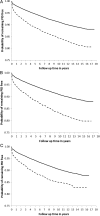Heterogeneity in risk of pelvic inflammatory diseases after chlamydia infection: a population-based study in Manitoba, Canada
- PMID: 25381374
- PMCID: PMC4231643
- DOI: 10.1093/infdis/jiu483
Heterogeneity in risk of pelvic inflammatory diseases after chlamydia infection: a population-based study in Manitoba, Canada
Abstract
Background: The association between chlamydia infection and pelvic inflammatory disease (PID) is a key parameter for models evaluating the impact of chlamydia control programs. We quantified this association using a retrospective population-based cohort.
Methods: We used administrative health data sets to construct a retrospective population-based cohort of women and girls aged 12-24 years who were resident in Manitoba, Canada, between 1992 and 1996. We performed survival analysis on a subcohort of individuals who were tested for chlamydia to estimate the risk of PID diagnosed in a primary care, outpatient, or inpatient setting after ≥ 1 positive chlamydia test.
Results: A total of 73 883 individuals contributed 625 621 person years of follow-up. Those with a diagnosis of chlamydia had an increased risk of PID over their reproductive lifetime compared with those who tested negative (adjusted hazard ratio [AHR], 1.55; 95% confidence interval [CI], 1.43-1.70). This risk increased with each subsequent infection: the AHR was 1.17 for first reinfection (95% CI, 1.06-1.30) and 1.35 for the second (95% CI, 1.04-1.75). The increased risk of PID from reinfection was highest in younger individuals (AHR, 4.55 (95% CI, 3.59-5.78) in individuals aged 12-15 years at the time of their second reinfection, compared with individuals older than 30 years).
Conclusions: There is heterogeneity in the risk of PID after a chlamydia infection. Describing the progression to PID in mathematical models as an average rate may be an oversimplification; more accurate estimates of the cost-effectiveness of screening may be obtained by using an individual-based measure of risk. Health inequalities may be reduced by targeting health promotion interventions at sexually active girls younger than 16 years and those with a history of chlamydia.
Keywords: Chlamydia trachomatis; cohort study; cost effectiveness; epidemiology; mathematical models; pelvic inflammatory disease; retrospective study.
© The Author 2014. Published by Oxford University Press on behalf of the Infectious Diseases Society of America.
Figures


References
-
- European Centre for Disease Prevention and Control. Stockholm, Sweden: European Centre for Disease Prevention and Control; 2009. Chlamydia control in Europe.
-
- Gottlieb SL, Berman SM, Low N. Screening and treatment to prevent sequelae in women with Chlamydia trachomatis genital infection: how much do we know? J Infect Dis. 2010;201(suppl 2)):S156–67. - PubMed
-
- Andersen B, Gundgaard J, Kretzschmar M, Olsen J, Welte R, Oster-Gaard L. Prediction of costs, effectiveness, and disease control of a population-based program using home sampling for diagnosis of urogenital Chlamydia trachomatis infections. Sex Transm Dis. 2006;33:407–15. - PubMed
-
- Low N, McCarthy A, Macleod J, et al. Epidemiological, social, diagnostic and economic evaluation of population screening for genital chlamydial infection. Health Technol Assess. 2007;11:iii–iv. ix-xii, 1–165. - PubMed
Publication types
MeSH terms
Grants and funding
LinkOut - more resources
Full Text Sources
Other Literature Sources
Medical

